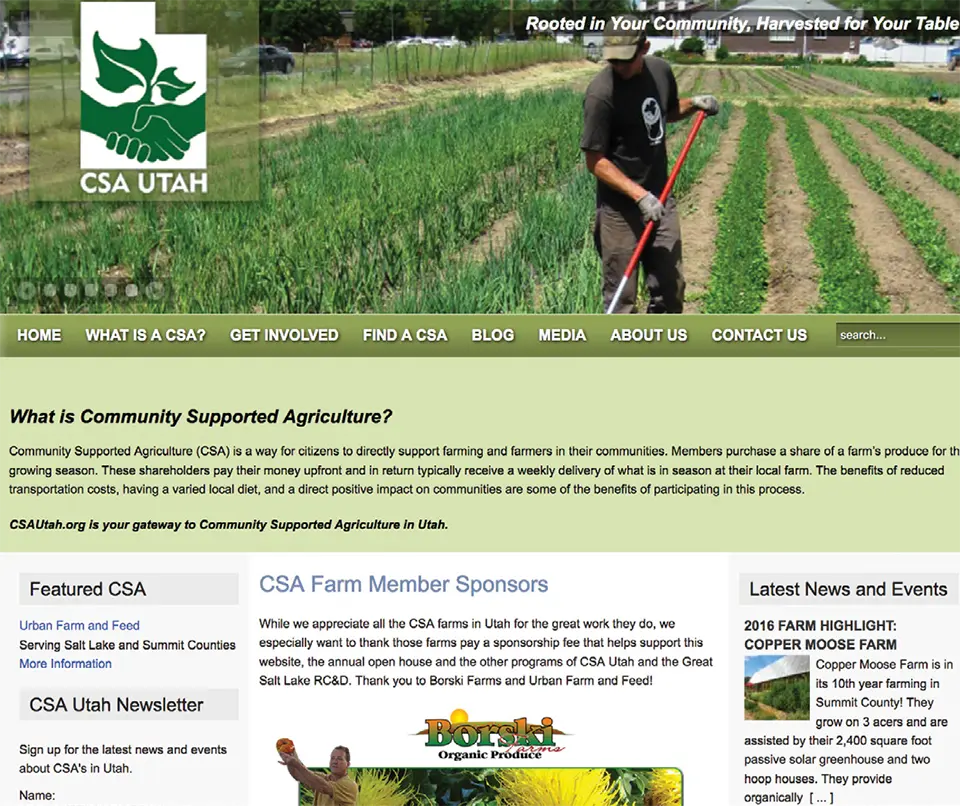Community Supported Agriculture: Definition, Benefits, Barriers, and Resources for Growers

What is Community Supported Agriculture?
Community Supported Agriculture (CSA) provides a direct connection between local community members and growers, generally through purchasing a weekly “share” of locally grown goods provided by the grower throughout a time frame (CSA Utah, 2016; LocalHarvest, 2016). CSAs provide locally grown produce, promote small businesses in the community, and help to cover production costs for growers.
A large range of goods can be provided by CSAs, depending on the type, location, and growing season. Vegetable CSAs are common, but many CSAs also offer fruit, eggs, meat, and even flowers. Some CSAs may also offer crafts and other services.
Types of CSA Models
There are different kinds of CSA models to choose from as you begin your CSA operation. This information will help you choose which model works best for your CSA.
Shareholder CSA: This is a consumer driven CSA. Consumers organize a CSA and hire you as a grower to work for them during the season (Bruch & Ernst, 2010). Shareholder CSAs can be a good model for the workplace. Workplace CSAs consist of shareholders who join from the same work environment. They are often established by gathering a group together from a specific office or business where shareholders already know each other. This is beneficial to you because it helps you focus marketing and distribution energy to a tailored group (Marks, 2011).
Subscription CSA: Subscription CSAs are more popular and are often the ones we think of when describing CSAs. This is when you market to the public in attempt to gain shareholders. You control the prices, produce options, and schedule delivery (Bruch & Ernst, 2010). Single farm CSAs offer produce from one farm while multi-farm CSAs offer produce grown from several farms, which offers potential for a larger range of crops and larger distribution (Bruch & Ernst, 2010). Many CSA operations have teamed with growers of different crops to collectively supply the wide diversity of produce and other foods that consumers prefer.
Benefits of Operating a CSA
A major benefit of operating a CSA is the guarantee of business at the beginning of the season. Shareholders make an upfront payment for the entire cost of the season. This money helps cover the start-up and production costs of the goods. This is a valuable asset that helps fight back against the many unpredictable factors of farming. You know beforehand to whom food is being delivered and how many shareholders will participate.
Community involvement is an additional benefit of CSA participation. You become better acquainted with community members as you market and deliver your goods and interact with your shareholders. Shareholders may become involved in the actual production of the CSA; another benefit to you. Shareholders can help with farm labor such as picking, pruning, and planting through organized workshops and activities. This provides additional labor to help with the tasks of crop management.
Barriers to Operating a CSA
You may experience a range of barriers in operating a CSA. Common barriers listed by growers include:
- Uncertainty of how to market your CSA in order to gain public interest and participation
- Weather discrepancies resulting in crop damage
- Maintaining high quality produce
- Problems with quantity (not enough of specific produce, too much produce, etc.)
- Improper facilities
- Not enough labor
- Administrative complexities
- Land security
CSAs in Utah

Key resources for learning about local food and community supported agriculture in Utah include:
- CSA Utah: http://csautah.org/
- Local Harvest: http://www.localharvest.org/csa/
- Local First Utah: http://localfirst.org/
- Urban and Small Farm Conference hosted by Utah State University Extension: http://diverseag.org/htm/2016-conference
- Utah State University Small Farm Program: https://smallfarms.usu.edu/
- Utah State University Extension publishes online fact sheets providing information about community supported agriculture, marketing, vegetable production, fruit production, plant problems, insects and more. To find a specific publication, search this website: http://extension.usu.edu/publications
- Utah’s Own: http://www.utahsown.org
- Your local farmers’ market

This sample list of USU Extension fact sheets may also be of assistance:
- Brain, R. (2012). The Local Food Movement: Definitions, Benefits & Resources. Retrieved from: https://digitalcommons.usu.edu/cgi/viewcontent.cgi?article=2693&context=extension_curall
- Curtis, K. (2010). Direct Marketing of Local Foods: Food Safety Considerations. Retrieved from: http://digitalcommons.usu.edu/extension_curall/99/
- Curtis, K. (2011). Direct Marketing Local Foods: Differences in CSA and Farmers’ Market Consumers. Retieved from: http://digitalcommons.usu.edu/extension_curall/100/
- Curtis, K., Chakreeyarat, V., & Dominique Gumirakiza, J. (2012). Community Supported Agriculture Programs: A Sustainable Approach to Local Foods. Retrieved from: https://digitalcommons.usu.edu/cgi/viewcontent.cgi?article=2013&context=extension_curall
- Curtis, K., Chakreeyarat, V., & Dominique Gumirakiza, J. (2013). Enhancing Direct Marketing Opportunities for Local Foods. Retrieved from: https://digitalcommons.usu.edu/cgi/viewcontent.cgi?article=2016&context=extension_curall
Summary
Community Supported Agriculture provides a connection between local growers and community members. Community members can purchase a “share” of food produced by growers and receive periodic deliveries of goods. There are many benefits associated with operating a CSA, including upfront payment and guaranteed business at the beginning of the season. However, barriers to operating a CSA also exist, and you must weigh the pros and cons before deciding whether a CSA is right for you.
Sources
- Bruch, M. L., & Ernst, M. D. (2010). A farmer’s guide to marketing CSAs (PB1797). Retrieved from University of Tenessee Extension website: https://extension.tennessee.edu/publications/documents/pb1797.pdf
- CSA Utah. (2016). What is Community Supported Agriculture? Retrieved from http://csautah.org/
- Local Harvest. (2016). Community supported agriculture. Retrieved from http://www.localharvest.org/csa/
- Marks, P. (2011). What’s next for CSAs? Retrieved from the Appalachian Sustainable Agriculture Project website: http://asapconnections.org/downloads/csa-toolkit.pdf
May 2017
Utah State University Extension
Peer-reviewed fact sheet
Authors
Kenna McMurray, Kelsey Hall, & Roslynn Brain
School of Applied Sciences, Technology & Education & Department of Environment & Society
Related Research




















































